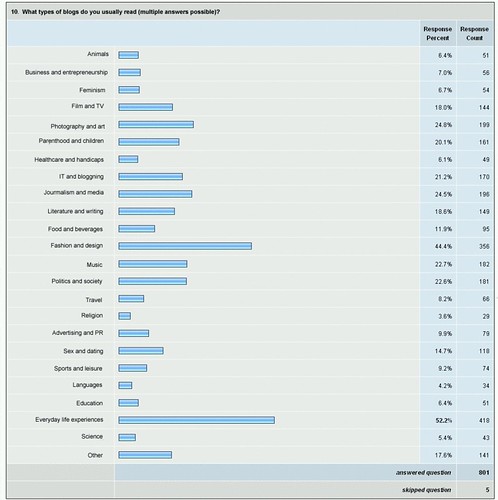Between January 1 and 2, 2008, a total of 1,000 Swedish blog readers responded to an online survey about blogs and social media. Of these respondents, 806 are bloggers and it is mainly their answers that are being presented in this report. The report, BlogSweden 3, is a follow up to BlogSweden 1 and 2 from May 2005 and June 2006.
In the survey, three out of four bloggers are women. Here are some more key findings.
Bloggers: The typical Swedish blogger in the survey is:
• Female
• 16-20 years old
• reads 1-5 blogs daily
• spends 1 hour per week reading blogs
• often reads blogs in the evening (6 PM to 12 PM)
• never uses an RSS reader to read blogs
• likes to read blogs about everyday life experiences
• reads blogs to be entertained
• has never clicked on an advertisement on a blog
• is a member of a social network in order to stay in touch with friends
• has during the last 12 months; downloaded video online, listened to radio online or downloaded podcasts, viewed or downloaded video online, have made photos accessible to others online, and has tagged information online.
• has not during the last 12 months; made videos accessible online, saved links via social bookmarking sites or visited virtual worlds.
• blogs because she likes to write
• updates her blog every day
• has nothing against being contacted by companies in her role as a blogger
• is not anonymous
• does not have ads on her blog, from which she gets part of the revenue
In fact, as many as 76.2% of the bloggers in the survey are female.

There are still some major differences between the way male and female bloggers behave:
• Women more often blog anonymously than men (49.2% compared to 34.0%).
• Male bloggers blog to a higher extent than female bloggers to market a product or a service, to influence others, to strengthen their brand, to create an archive of information and because there is a need for more voices in the public debate.
• Female bloggers blog to a higher extent than male bloggers to get in touch with others and to stay in touch with friends and family.
• 66.5% of all bloggers update their blog every day. Female bloggers update their blogs more often than male bloggers (74.1% at least once a day, compared to 42.6% of male bloggers).
• Male bloggers more often than female bloggers have ads on their blogs (14.3% compared to 7.4%).
When a blogger forms an opinion about a company, she thinks that “a person like me or a peer” is the most trustworthy spokesperson. “A blogger” is as trustworthy as the company CEO, according to bloggers.
One in three bloggers have bought a product after reading about it on a blog. An equally high proportion of bloggers have refrained from buying a product after reading information or opinions on a blog. One in three have, after reading information on a blog, acted in order to influence a company or a politician on an important topic.

There are also significant differences between how female and male blog readers behave (all respondents in the survey):
Female blog readers prefer reading blogs about:
• Fashion and design (53.0%)
• Everyday life experiences (51.6%)
• Photography and art (26.6%)
• Parenthood and children (24.3%)
• Music (22%)
• Literature and writing (17.2%)
• Movies and tv (16.9%)
• Journalism and media (16.7%)
• Sex and dating (16.5%)
• Politics and society (14.4%)
Male blog readers prefer reading blogs about:
• Politics and society (49.2%)
• IT and blogging (45.8%)
• Journalism and media (45.3%)
• Everyday life experiences (39.4%)
• Advertising and PR (25.8%)
• Movies and tv (25.4%)
• Music (23.7%)
• Photography and art (19.5%)
• Literature and writing (18.6%)
• Economy and entrepreneurship (15.7%)
Over all, the favorite topics of blog readers are blogs about:
• Everyday life experiences (48.6%)
• Fashion and design (44%)
• Photography and art (24.9%)
• Journalism and media (23.8%)
• Politics and society (23%)
Here is a table of the most popular blog categories among bloggers:

The report BlogSweden 3 is free to download under a Creative Commons license and if you would like to discuss the findings you can join Media Culpa on Facebook or find me on Twitter. More graphs can be found at Flickr.
Footnote: The respondents were chosen through a convenience sample which means that the results from this survey is only representative to the respondents of the survey and not necessarily reflect the profile of all Swedish bloggers and blog readers.
Tags: social media, surveys, blogsweden3, enkät, sociala medier, bloggsverige3, bloggar. Ping.





